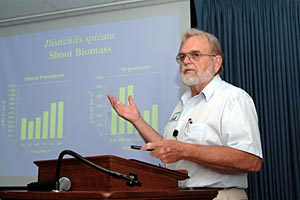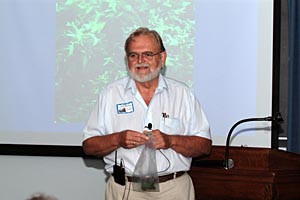

UDAILY is produced by the Office of Public Relations
150 South College Ave.
Newark, DE 19716-2701
(302) 831-2791
|
 |
Salt-marsh plants can reduce food shortages, UD prof says
10:10 a.m., Aug. 1, 2003--From providing alternative salad ingredients to restoring saline-damaged environments to a productive state, salt-marsh plants, or halophytes, have the potential to play a key role in worldwide economic development and environmental responsibility.
 |
| Jack Gallagher, UD professor of marine biology/biochemistry, and co-director of the Halophyte Biotechnology Center in the College of Marine Studies |
Jack Gallagher, UD professor of marine biology/biochemistry, and co-director of the Halophyte Biotechnology Center in the College of Marine Studies (CMS), addressed many of the environmental and economic concerns associated with halophyte research during a talk on “Salt-Marsh Plants Serving Society,” on July 17 in Cannon Laboratory on the Hugh R. Sharp Campus in Lewes. The free public program was part of the Ocean Currents Lecture Series.
“We need to use salt-marsh plants to help take care of the agricultural needs of the world,” Gallagher said.“ “We can use this type of plant to meet both animal and human needs.”
While salt is toxic to most plants and inhibits them from extracting water from the soil, plants such as spartina (cordgrass), distichlis (saltgrass) and salicornia (pickleweed) have evolved mechanisms that allow them to survive in saline coastal marshlands, he said.
“Over the years, our laboratory has focused on studying the relatively small group of flowering plants that not only survive but actually thrive in saline environments,” Gallagher said.
In the First State, about 90,000 acres of salt marshes line the Delaware River and Bay estuaries, while nationally there are some 12 million acres of salt marshes.
Besides being able to survive in salty soil, halophytic plants can be cultivated to grow in areas where years of irrigation, poor drainage and imbalanced fertilizer use have caused a buildup of salt in the soil.
“About 10 percent of the Earth’s soil is salt-affected,” Gallagher said. “By planting salt-marsh plants developed as crops, we can restore saline soil to productivity. Salt water can be use to irrigate these salt-tolerant crops, while using freshwater supplies for direct human and animal use.”
Researchers, Gallagher said, are interested in how the biology of these plants differs from that of plants damaged by salt, as well as the nature of their ecological role in their native habitats.
“We try to identify which problems facing societies near and far from the estuary might be solved by unconventional uses of these plants,” Gallagher said. “We then work on ways to match the plant with the solution of the problem and improve the plant for its new purpose.”
Although salt-marsh plants have a long history of aesthetic, agricultural and medicinal uses, they also serve coastal communities as a form of protection from storms and floods, he said.
 |
| Gallagher offers a recipe for “Seaside Greens Pasta.” |
Worldwide, salt-marsh plant selections from the Halophyte Biotechnology Center in Lewes are being studied in places like Thailand, where the early success of experiments with planting sporobolus (dixie), to be used as forage and hay have been successful.
These Delaware “marsh crops”—pioneered by Gallagher and Denise Seliskar, fellow Delaware Sea Grant scientist and codirector of the Halophyte Biotechnology Center—also are being tested in China, Egypt and Israel.
“For applications abroad we primarily make use of approaches appropriate for improving plants in general, rather than specialized protocols for the specific plants we are using here,” Gallagher said. “Given the large area of salt-afflicted soil worldwide and the enormous acreage of dry land adjacent to oceans and estuaries, the potential for helping to solve food and feed shortages is very high.”
Closer to home, a species known as phragmites australis (common reed), is being improved to enhance the drying and decomposition process in wastewater treatment plants such as the one in Bridgeville. This approach, he noted, has the potential to expand the capacity of the wastewater plant’s sand-drying beds and could become a money saving venture for small towns.
Gallagher and his colleagues also are experimenting with ways to discourage the invasive growth of some phragmites in wetland areas. The highly invasive species is spread by runners that approach 30 feet, with the strength to grow under and through concrete.
Gallagher also noted CMS researchers have participated in restoring marshland areas destroyed or damaged by construction projects and development.
“At this time, the environmental application of our work for wetland restoration and bio-solids drying is greatest at home,” he said.
Seaside greens pasta
- 2 cups flour
- 2 eggs
- One-plus tablespoon oil and an equal amount of water
- 1/2-plus cup of seaside greens powder
Mix dry ingredients and add eggs and oil. Knead, adding water to consistency. Let rest five minutes and process through pasta maker.
|
Although he offered members of the audience a recipe for “Seaside Greens Pasta,” Gallagher noted that while such items may one day become a staple of our diet in Delaware, the key ingredient, seaside greens powder, is not available at your local supermarket.
“While home use is not that great at present, the specialty crop market has potential,” Gallagher said. “Also, changes in climate, resources and population may change the economics of such crops in the future.”
A member of the faculty since 1980, Gallagher holds a bachelor’s and master’s degree in agronomy and a doctorate in biology, all from UD.
Article by Jerry Rhodes
Photos by Eric Crossan
|
 |

[an error occurred while processing this directive]
|

